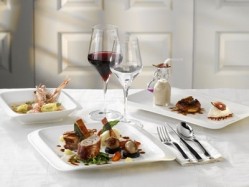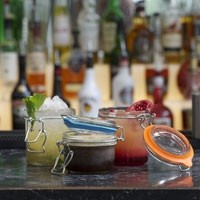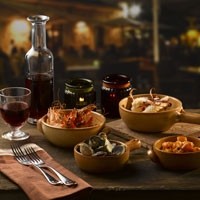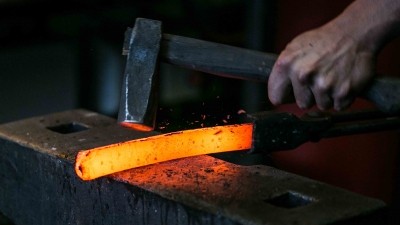Design: Choosing tableware and glassware

When it comes to design, it is easy to concentrate on the big things- furniture, wallpaper, windows – and forget about the impact that smaller details like glassware and tableware can have on the overall ambiance of your venue.
However, Julian Williams, managing director of EveryWare for the EMEA region, says the right tableware is an essential part of any dining design – particularly now that cash-strapped consumers are craving a true ‘experience’ on the occasions they do eat out of home.
“Making a meal memorable doesn’t just have to be about the food and service, however – quality table and glassware and savvy settings can also help to create the right ambiance, ensuring that your food and drink is given the best possible chance to shine,” he explains.
“Neglect this and your customers will know – a dirty glass or chipped plate could be as detrimental to your reputation as rude service or bad food.”
Point of difference
Williams says that consumer eagerness for an ‘experience’ and the rise of casual dining means many operators are looking beyond simple white porcelain and choosing tableware in colours and textures that offer a point of difference.
“As a canvas the white presents the food beautifully which is why chefs love it so much, yet interesting textures, finishes and even colours, inspired by the rise of Scandinavian tableware and concepts like Noma, are increasingly finding favour,” he says.
Ian Jelley, sales & marketing director at Artis, agrees that while white porcelain remains a firm favourite among chefs, other materials and colours are growing in popularity.
“Subtly coloured glazes, with a more handcrafted, rustic, or organic feel – duck egg blue/grey and browns in matt finishes, with a Scandinavian feel, are hot right now,” he says.
“Over the past year, we’ve also seen strong trends for the use of natural materials, including slate used as a serving platter and the incorporation of dark wood trays, used in conjunction with porcelain pieces for presentation of dishes to the table.”
However, not all operators are opting for stripped-back Scandanavian styles. According to Williams there has also been a surge in the popularity of retro and vintage tableware of late.
“We are seeing a real fashion for heavy baroque ornaments and silver plated and even gold detailing entering the cutlery market,” he explains. “This is much more about vintage identity than formality though."
Retro and vintage glassware is also growing in popularity, according to Jelley. “There is a noticeable renaissance in cut glass crystal emerging and a demand for vintage style cocktail glasses,” he says.
Subverting the norm
Just as non-traditional dinnerware colours are coming in to fashion, so are more unusual shapes and sizes.
“We are seeing a continued trend for unusual shapes of tableware, and for small, ‘dinky’ sizes for haute cuisine tasting menus and amuse-bouche. Sharing dishes are also very popular,” says Jelley.

Nick Green, national sales & marketing manager for Villeroy & Boch Hotel & Restaurant, says that while the more traditional deep and ‘coupe’ plates remain popular, geometric and asymmetric plates offer a ‘stylish and easy’ way to offer guests a memorable dining experience.
“Square plates are an old favourite, and much like deep plates are versatile enough to be used for a variety of courses,” he says. “Rectangles are also a great shape and work well with a lot of the new food trends.”
According to Williams, savvy operators can also create a point-of-difference and save cash by re-using tableware and glassware in unusual ways - such as by serving ice cream in martini glasses and cocktails in click jars.
“Not only does this make sense from a financial point of view, but subverting the functionality of certain pieces can also leave a lasting impression and give your operation a real quirky point of difference,” he explains.
Taking the plunge
Replacing all of your dinnerware and glassware can be an expensive undertaking, but Nick Green, national sales & marketing manager for Villeroy & Boch Hotel & Restaurant, says you can save money by picking out a few stylish new pieces to add to your existing collection.
“By matching the body colour of your current dinnerware to the accessory pieces, two new plates can dramatically change the tabletop,” he explains.
A 60 seat restaurant which turns its tables twice, for example, could purchase 40 plates in one style and 40 plates in another, then mix new with old to create a new look.
“At an average cost of £10 per plate, this is a £800 purchase,” says Green. “With 120 meals a night, over four nights a week, if the operator can increase cost by 20 pence per menu item the new plates are paid for in eight weeks.”
He adds that by enhancing the guest experience, operators will have also improved customer loyalty which should drive return visits and ensure short payback times
Hints & tips on choosing tableware
- Starting with glassware, choose a style that suits your establishment’s personality and clientele and then reflect that in your other choices for china, cutlery and linen.
- Identify what overall atmosphere you are aiming to create at your establishment. When selecting tableware, try to identify who your target market is and the needs and expectations of that market
- Plan your selection strategically and avoid selecting items in a knee-jerk fashion. Think carefully about how you will use each item of tableware and look for products that multi-task, doubling up for many uses, thereby making cost savings.
- Try not to mix qualities - if you can afford the best and it suits your restaurant, go for it, but don't blow the budget on fabulous glassware and then compromise on crockery.
- Try to balance the elements on the table. The height/size of glassware and cutlery should ideally be in proportion to the size of the plates you choose, and to the size of the table. Try not to overwhelm petite plates with over-sized knives and forks, or tall stemware – and vice versa.
- Remember not to clutter the table with too many items. Keep it simple and leave enough space for diners to do what they’ve come to do – dine. Less is often more.
- A total freshening of your tableware should be undertaken every few years, as trends change – however, a change of mood can be easily achieved by keeping dining services classic and then interchanging/replacing other elements such glassware, table lighting, vases and napkins.


















